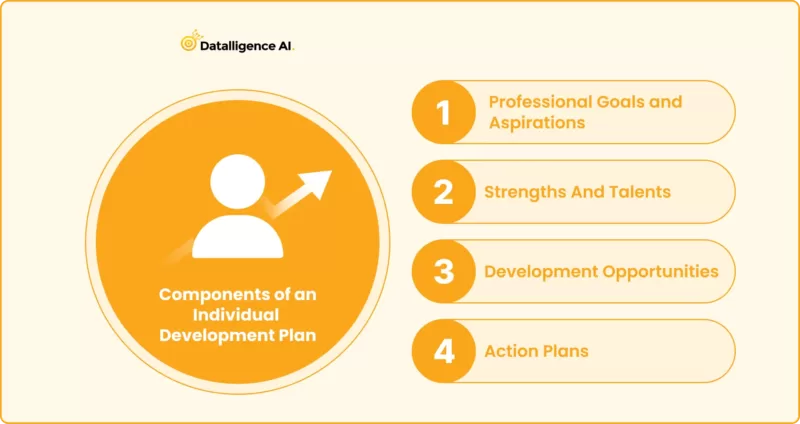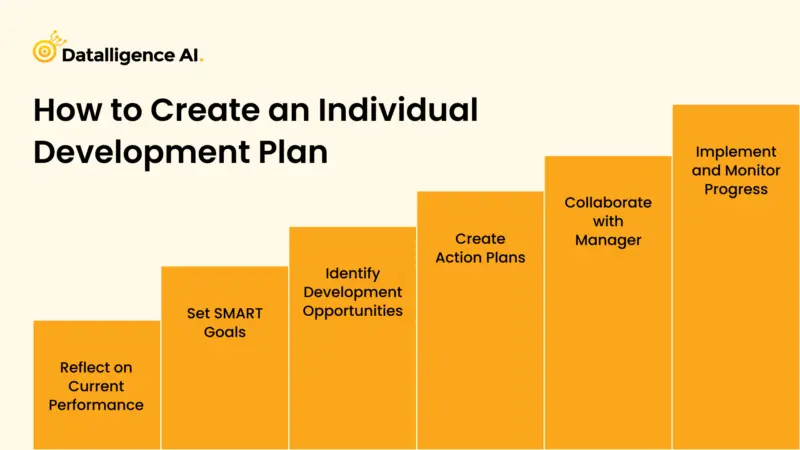Individual development plan ideas is a personalized agreement between an employee and his or her employer that sets out the employee’s professional growth and development aims. It provides guidance to the worker on how they can acquire new competences, enhance their output and meet their career dreams within a specified time frame. The IDP has a detailed action plan of specific steps to be taken by the employee in order to reach his/her goal.
An IDP is basically designed as an overall structure for personal and professional growth for employees. This assists them to identify their strengths and weaknesses, set goals that are achievable, as well as take steps that can improve their skills and performance. The IDP documents this process, therefore acting as a guidepost for both the employee and employer to monitor progress while making necessary changes along its’ path.
What is an Individual Development Plan ideas?
What is an individual development plan(IDP)? It’s a personal roadmap that outlines your occupational growth targets and the actions you need to take in order to realize them. A strategic instrument helps you identify areas for improvement, leverage on your strong points and line up your dreams with career path. IDP serves as a manual, which gives a clear picture of what should be done and where one should head.
A Step-by-step guide to achieving individual development with personal OKRs
Achieving individual development with personal OKRs involves a structured approach that aligns personal goals with measurable outcomes. This process begins with self-reflection and ends with continuous evaluation and adjustment.
- Define Your Purpose:
Start by asking yourself essential questions about your ambitions, priorities, and long-term vision. Consider what you want to achieve and why it matters to you. This reflection helps establish a clear direction for your Individual Development Plan. - Set Objectives:
Break down your long-term mission into shorter-term objectives. These should be aspirational yet achievable goals that contribute to your overall development. For example, if your long-term goal is to create multiple income streams within five years, a shorter-term objective could be to become a YouTuber with 1000 subscribers within a year. - Establish Key Results:
For each objective, define specific, time-bound, and measurable key results. These are the milestones that indicate progress toward your objectives. Using the YouTube example, key results could include opening a channel within a week, posting six videos monthly, and earning 100 subscribers each month. - Plan Initiatives:
Develop actionable steps to achieve your key results. These initiatives are the specific tasks and activities you’ll undertake. For the YouTube objective, initiatives might include defining your channel’s theme, creating a content calendar, and promoting your videos on social media. - Implement and Track: Put your plan into action and consistently track your progress. Use a scoring system to evaluate your achievements, such as grading your OKRs on a scale of 0 to 1.0. Regular check-ins, whether weekly or monthly, help maintain focus and allow for timely adjustments.
- Review and Adjust:
Periodically review your OKRs and make necessary adjustments. This flexibility ensures your plan remains relevant and effective as circumstances change.
By following this step-by-step guide, individuals can leverage the power of personal OKRs to drive their development and achieve meaningful growth in both personal and professional spheres.
Components of an Individual Development Plan
An individual development plan typically consists of several key components that provide a comprehensive overview of the employee’s professional goals and aspirations. These components include:

1. Professional Goals and Aspirations
The professional goals and aspirations section of the IDP outlines the employee’s desired outcomes and objectives. It includes specific goals they want to achieve, such as advancing to a leadership position or completing a certain project. These goals should be realistic, measurable, and aligned with the employee’s long-term career aspirations.
2. Strengths and Talents
In this section, the employee identifies their strengths, skills, and talents. It could be based on their performance reviews, feedback from colleagues, or self-assessment. Recognizing and leveraging these strengths can boost the employee’s confidence and help them excel in their current role or pursue new opportunities.
3. Development Opportunities
The development opportunities section focuses on areas where the employee can enhance their skills or acquire new ones. It could include attending training programs, pursuing certifications, or participating in professional development courses. These opportunities should be aligned with the employee’s goals and contribute to their overall growth and success.
4. Action Plans
The action plans section outlines the specific steps the employee will take to achieve their goals and seize development opportunities. It includes actionable tasks, timelines, and resources required to accomplish each step. These action plans should be specific, measurable, achievable, relevant, and time-bound (SMART), enabling the employee to track their progress effectively.
How to Create an Individual Development Plan
Creating an effective individual development plan involves a collaborative effort between the employee and their manager. The following steps can guide the process:

1. Reflect on Current Performance
The first step is for the employee to reflect on their current performance and identify areas for improvement or growth. They can review their past performance reviews, feedback, and self-assessment to gain insights into their strengths and weaknesses.
2. Set SMART Goals
Based on their reflections, the employee should set SMART goals for their professional development. These goals should be specific, measurable, achievable, relevant, and time-bound. They should align with the employee’s long-term career aspirations and contribute to their overall growth.
3. Identify Development Opportunities
Next, the employee should identify specific development opportunities that align with their goals. This could include enrolling in training programs, attending workshops or conferences, seeking mentorship, or pursuing certifications. It is important to choose opportunities that will enhance their skills and contribute to their desired career trajectory.
4. Create Action Plans
Once the goals and development opportunities are identified, the employee should create action plans. These action plans should outline the steps they will take to achieve their goals and seize the identified development opportunities. Each step should be specific, measurable, and time-bound to ensure progress can be monitored.
5. Collaborate with Manager
The employee should then meet with their manager to discuss their individual development plan. The manager can provide guidance, offer feedback, and suggest additional resources or opportunities. This collaborative discussion ensures that the plan is realistic, aligned with organizational goals, and mutually beneficial.
6. Implement and Monitor Progress
After finalizing the individual development plan, it’s time for the employee to implement the action steps and monitor their progress. Regular check-ins with the manager can help track progress, identify any challenges, and make necessary adjustments to the plan. This ongoing feedback and support are crucial for the employee’s growth and development.
Benefits of Individual Development Plans
Implementing individual development plans within an organization offers numerous benefits for both employees and employers.
1. Employee Engagement and Satisfaction
Individual development plans provide employees with a sense of purpose, direction, and growth opportunities. When employees feel supported in their professional development, they are more engaged, motivated, and satisfied with their work.
2. Skill Enhancement and Performance Improvement
By focusing on specific skill development, individual development plans help employees enhance their capabilities and performance. This leads to increased productivity, higher quality work, and improved job performance.
3. Career Advancement Opportunities
Individual development plans enable employees to set clear goals and create actionable steps for career advancement. By continuously developing their skills, employees are better positioned to take on new responsibilities, pursue promotions, or explore new career paths within the organization.
4. Talent Retention and Succession Planning
Providing employees with opportunities for growth and development enhances their loyalty and commitment to the organization. Individual development plans contribute to talent retention by demonstrating that the organization values its employees’ professional aspirations. Moreover, these plans support succession planning by identifying and nurturing internal talent for future leadership positions.
5. Improved Communication and Collaboration
The process of creating individual development plans encourages open communication and collaboration between employees and their managers. This fosters a supportive and constructive work environment, where employees feel comfortable discussing their goals, strengths, and areas for improvement.
How Performance Appraisal Software Supports Individual Development Plans
Performance appraisal software plays a crucial role in shaping Individual Development Plans (IDPs) by offering structure, clarity, and ongoing insights. It helps managers and employees identify skill gaps, track progress, and align personal growth with organizational goals. Through continuous feedback, goal tracking, and data-driven evaluations, the software enables smarter development planning, making growth measurable and actionable. It also ensures that development conversations are timely and not limited to annual reviews—turning appraisals into a strategic growth roadmap.
Conclusion: Empowering Growth with Individual Development Plans
Creating and implementing an individual development plan is a powerful tool for fostering professional growth, enhancing skills, and achieving career goals. By providing a structured framework for goal setting, development opportunities, and action plans, IDPs contribute to employee engagement, job satisfaction, and organizational success. Embracing the IDP process empowers employees to take ownership of their growth and enables organizations to build a talented, motivated, and skilled workforce.
At Datalligence.AI, we understand the importance of individual development plans in nurturing talent and driving organizational growth. Our comprehensive solutions support organizations in implementing effective IDP processes and empowering their employees to reach their full potential.











